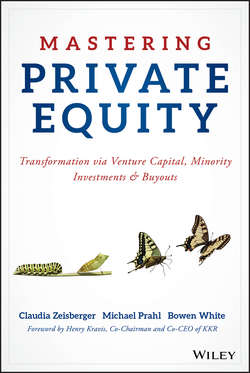Читать книгу Mastering Private Equity - Prahl Michael - Страница 18
На сайте Литреса книга снята с продажи.
SECTION I
PRIVATE EQUITY OVERVIEW
2
VENTURE CAPITAL
START-UP DEVELOPMENT
ОглавлениеVENTURE CAPITAL TARGETS
A start-up will navigate several stages of development before reaching profitability and a steady state of operation. Along the way, the company draws capital and expertise from different types of investors in the VC ecosystem. While each start-up follows a unique path, three distinct stages of development can be defined: proof-of-concept, commercialization, and scaling up. It should be noted that the vast majority of start-ups will never reach this final phase of accelerated growth.
Exhibit 2.2 highlights the type of investment required at the respective stage to successfully grow and scale a business.
Exhibit 2.2 Start-up Development and Funding
PROOF-OF-CONCEPT: Companies at this stage have little or no track record and only a concept of a product, technology or service. Small amounts of funding are required to conduct product feasibility studies, define relevant markets, formulate a business plan, and develop a prototype. Once the product or service is developed, engaging with and securing a user base to show that the idea has the potential to translate into a successful long-term business is a critical step to achieving proof-of-concept and attracting further funding; it also shows that the founding team has the ability to execute. During the proof-of-concept stage, company development is funded by seed investment often provided by the entrepreneur, friends and family, business angels or seed-stage VC investors.
COMMERCIALIZATION: After a company’s value proposition has been validated by a group of core customers the focus shifts to translating the idea into an operating business and growing the top line. Companies at this stage of development focus on refining the product or service offering, expanding the sales and marketing functions, filling out missing capabilities in the core management team, and targeting large-scale customer acquisitions. They start to generate revenue but are far from cash flow positive; building up operations naturally increases operating cost, which combined with the initial working capital and capital expenditure needed in a growing business results in a high burn rate. In many cases, funding raised from VCs to drive commercialization are the first injections of institutional capital.
SCALING UP: This stage is all about expansion and market penetration. By now, companies are typically growing exponentially and are on their way to profit or even operating cash flow breakeven. However, profits generated from operations are reinvested in the company and may need to be supplemented by additional VC funding to meet market demand. In addition to rapidly growing a start-up’s core offering, funding is needed to expand product and service offerings to differentiate the company from competitors and to balance product-specific sales fluctuations. Mid- and late-stage VC investors, along with growth equity funds, are the main investors at this stage.
Box 2.1
VENTURE CAPITAL REMAINS US FOCUSED
Geographic location is crucial for VC as an asset class, given the importance of networks when growing early-stage companies. The deepest, most “developed” VC ecosystems can be found in the United States – Silicon Valley in particular – but other geographies such as China, India, Europe and Israel have seen active clusters emerging. Successful VC communities not only have complementary funding vehicles that support early-stage growth with angel investors, crowdfunding platforms, corporate venture capital, and government funding vehicles, but provide ready access to follow-on rounds and serve as magnets to attract the talent needed to scale quickly. Exhibit 2.3 shows the total amount of venture capital invested by geography over three consecutive five-year periods starting in 2001.
Exhibit 2.3 Global VC Investment by Geography
Source: Preqin
